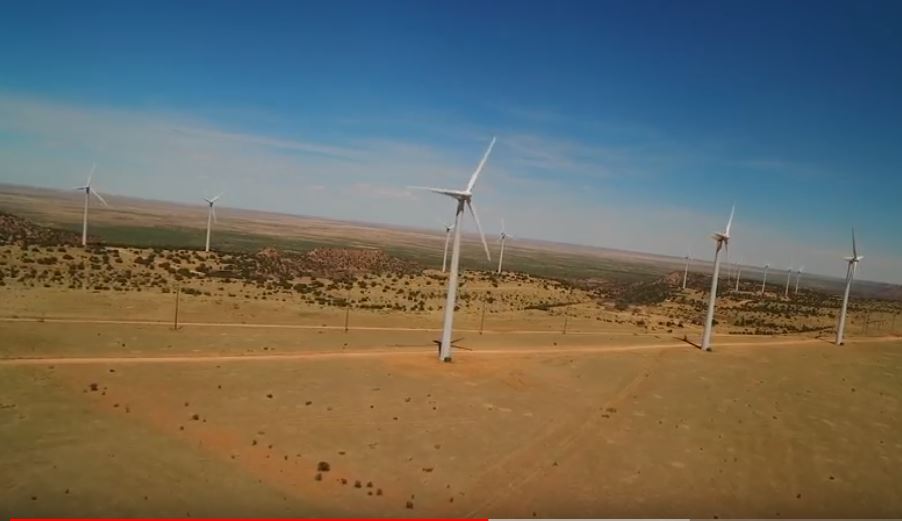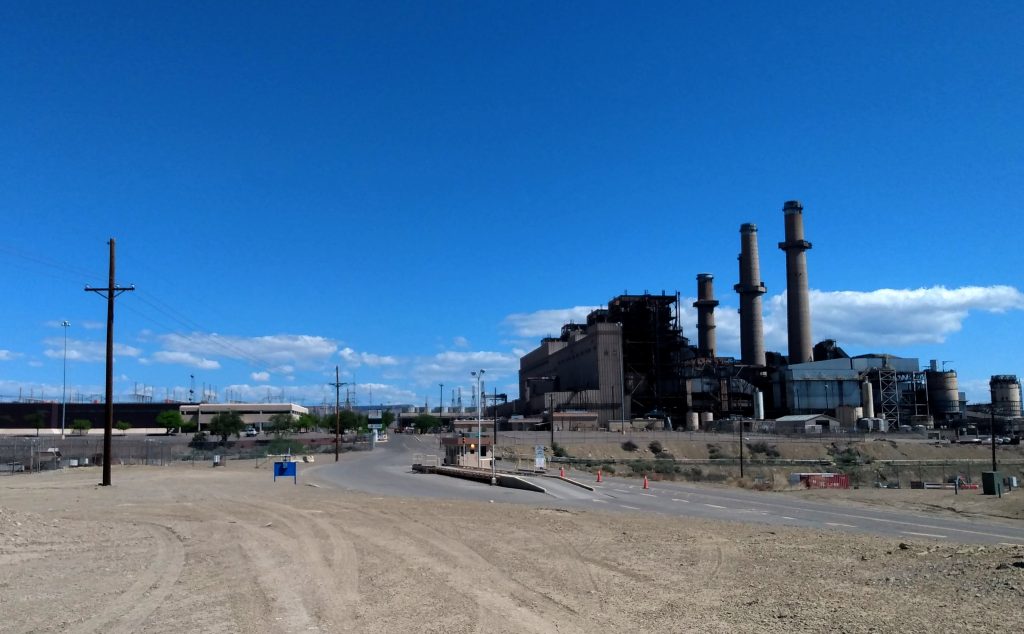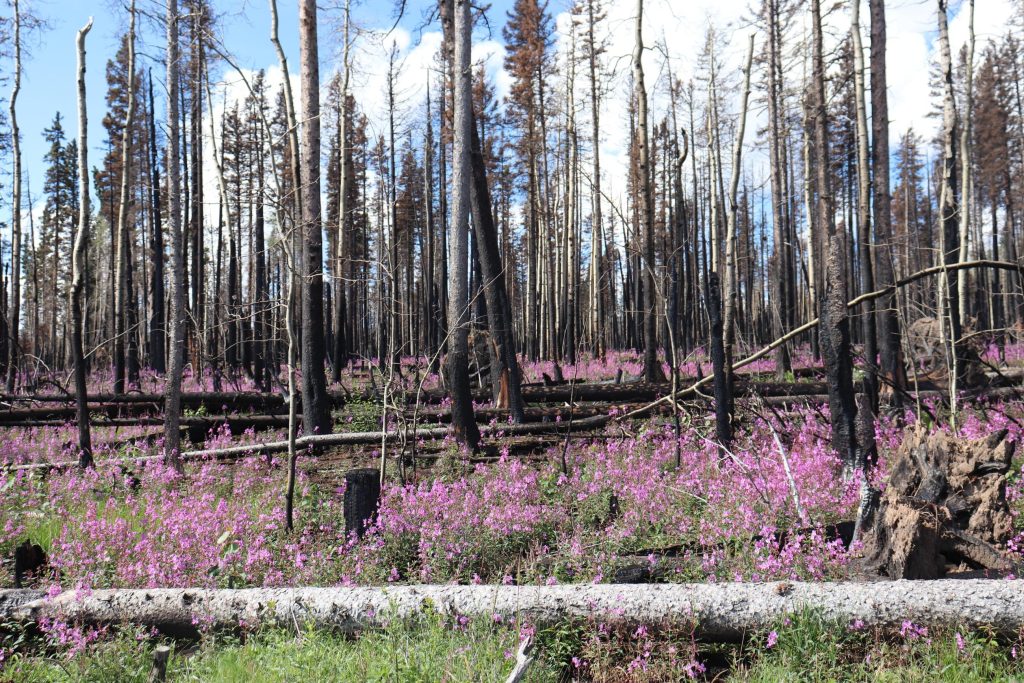Inside the New Mexico State Land Office, current Land Commissioner Aubrey Dunn sits at a dark wood desk ringed with a painting of the Rio Grande Gorge, a saddle, and a pair of leather chaps pinned on the wall, homages to a lifetime spent on cattle ranches. But it’s the decor outside that tends to draw more attention: Dunn installed a model pump jack in front of the State Land Office building on Old Santa Fe Trail. Its bobbing head —powered by a solar panel — is a familiar sight in oil country.
From that desk, he manages the state’s land trust: 9 million acres of surface land, and 13 million acres of mineral estate. It’s his job to maximize revenue from those acres through leases for businesses, grazing and rights-of-way, royalties from mining potash, coal, salt and caliche, and above all, fossil fuels, which accounts for 92.7 percent of the revenue generated the office. In a single oil and gas lease bonus sale held in July, the office brought in $15.4 million, which is more money than any other land use generates in a year.
Dunn has served as land commissioner for four years and opted out of re-election for the spot to instead try for Sen. Martin Heinrich’s seat, though he has since withdrawn from that campaign. He took the pump jack down in July, with plans to relocate it to San Juan College in Farmington, in case his successor doesn’t appreciate it.
The decorative oil derrick symbolizes the office’s deeply entrenched financial loyalties to the industry, but it’s also served as testament to the office’s independence. Dunn is at least the second land commissioner to post one out front. In 1979, then-Commissioner Alex Armijo also installed one, and his victory in a city lawsuit that declared Armijo’s “educational exhibit” a zoning violation affirmed that the commissioner’s authority over state lands pre-empted other interests.
“The limits to a commissioner’s authority to do different things with state trust lands is almost just the limits of their imagination,” says Ben Shelton, with Conservation Voters New Mexico. “This is a land manager that has more authority than almost any position in the western states.”In some ways, the commissioner is beholden to many interests and accountable to few. Though there’s an advisory committee that provides recommendations, there’s no real oversight other than the voters who weigh in every four years. The commissioner simply strives to produce revenue for the Land Grant Permanent Fund, which is then invested and returns paid out to 22 beneficiaries, including public schools, universities, the state penitentiary and state parks. Public schools receive 85 percent of the income generated by the office, covering about a third of their budget.
That freedom has state Rep. Stephanie Garcia Richard of Los Alamos, the Democratic candidate for Dunn’s spot, looking at increasing revenue from wind and solar on state trust lands, with hopes that it would support expanding early childhood education.
While 11 renewable energy projects are running on state lands and producing enough power for more than 1 million homes, the office estimates they contribute just 0.9 percent of its annual revenue. But renewables advocates point to untapped potential.
National trends show solar and wind on the rise. The U.S. Energy Information Administration predicts wind generation will increase by 8 percent and solar power by 24 percent this year. How New Mexico capitalizes on that growing market remains to be seen. Six of the top 10 states for solar growth over the past decade ring New Mexico, and five leading the way for wind power cluster to the east, according to a report by Environment America. Despite being surrounded by what appears to be a ready climate and thriving nearby markets for renewable power, New Mexico didn’t make either list.
With the U.S. moving to the lead in global oil production and business booming in the Permian Basin in southeastern New Mexico, no one imagines a swift end to the oil and gas industry or the revenue it generates for the state. It’s not an either/or conversation, advocates say, but a chance to add to and diversify revenue sources. The two industries, oil and gas and renewables, are often pitted as opposites, but as Shelton points out, oil and gas companies rank among the top solar consumers in the state: lots of pump jacks in San Juan County are powered by solar panels, just like the one that was in front of the state land office.
Between the work of his previous tenure as public land commissioner and his more recent terms on the Public Regulation Commission, Republican candidate Patrick Lyons says he thinks he’s probably worked on every renewable energy project in the state in some capacity.
He’s running to return to an office he held from 2003 to 2010, during which time he issued the first wind lease on state trust lands. He points, repeatedly, to the job’s responsibility to make money for school children, and argues it’s tough to fulfill that duty focusing on wind power. How much time and attention goes to those projects under his watch, he says, would also depend on how much the Legislature increases the renewable portfolio standard for the state.
If the road ahead leads to more renewables
Garcia Richard, with bobbed brown hair and a habit of rolling her R’s through local place names, particularly those for her grandfather’s ranch in northern Quay County, was still a full-time school teacher when the bottom dropped out of the economy in 2008. She recalls ripples hitting classrooms in the form of shortened school weeks and curtailed raises for teachers. The experience drilled in some tough lessons about fickle funding sources. After three terms in the state Legislature, she’s turned to the public land commissioner’s race, she says, to make a difference for schools by bringing the perspective of an educator to the office.
She would also be the first woman to hold the job, and she’s concerned her gender is fueling a conversation around her qualifications.
“It’s kind of a cool glass ceiling left to break; it feels good,” she says. “Just because of the nature of this seat, people don’t typically picture a woman holding it — do you have the negotiating power? Can you be tough, you know, negotiating on behalf of the state? It’s just funny that people don’t really picture a woman doing that. ”
The State Land Office oversees two funds, one fed by royalties from and the sale of nonrenewable resources like fossil fuels and minerals, and one fed by more recurrent sources, like grazing and commercial lease payments, rights-of-way permits, and fees — categories that include income from solar and wind energy production. Garcia Richard has set her sights on this second fund, the Land Maintenance Fund, with a goal of seeing renewable energy pay for universal access to early childhood education. State policymakers say they prioritize the program, but perennially battle over how to pay for it. Growing renewable energy projects would be the right move for so many reasons, she says, stable funding and slowing climate change among them.
“There’s all this talk all the time about the potential, the potential, the potential — how many days of sunshine we have, how windy it is on the east side — but there’s been no champion,” she says while sitting on a couch in her campaign manager’s house in north Santa Fe, bracketed by campaign posters with near life-sized portraits. Her work sprawls from daytime hours spent as curriculum coordinator for Pojoaque schools to an evening of phone-banking.
Oil and gas will continue to play a part in funding schools she says, but she argues the enabling act that created the commissioner’s position “doesn’t say the fiduciary responsibility is at all costs.” It reads “in the best interest,” she says “and in the best interest to me means sustainable use in order for there to be any resource after we’re gone, so this isn’t the only generation to benefit.” Increasing use of renewables could go into the fund that pays for long-term planning for the state’s watersheds, ecosystems and wildlife — taking care of the state and its natural resources so there’s some left for future generations.
When Ray Powell, a previous land commissioner and candidate this year until health reasons precluded another run, knew he had to end his bid, he recruited Garcia Richard. Renewable energy was at the top of an “almost unlimited” list of things he wanted to get done in a return to the office, which would have been his third, following terms from 1993 to 2002 and 2011 to 2014. During those previous stints, his staff studied where to develop solar, wind and geothermal projects, and his takeaway: “It doesn’t take a lot of space, if you do it right, to generate enormous amounts of energy.”
He says he had $700 million in renewable energy projects outlined when he left, but that Dunn abandoned those projects when he took over. Garcia Richard has been touting that figure, but when pressed for more details, had none. State Land Office annual reports mention in-progress renewable energy projects that would have produced $500 million over their lifetimes, which stretch to 35 or 40 years. Dunn says it’s not true that he canceled anything, and that he only postponed two solar bids scheduled for his third day on the job, taking 90 days to review them, then making some changes to secure more money for the state.
Garcia Richard lists some big picture ideas for moving forward. State trust lands were allocated in a checkerboard in a system four square miles per township. The land office map shows tiny, pale blue squares the state owns scattered amid federal and private land. They’re not even close to adjacent unless land has been exchanged or purchased; in those places, they’ve been assembled Tetris-like into blocky clumps. These few consolidated spots, like one in Curry County on the eastern state line, she says, could be ideal for wind development. State trust lands that are now just empty lots next to strip malls could host small-scale, distributed solar installations. A model for that system is emerging in the Kit Carson Electric Cooperative that serves Taos, Rio Arriba and Colfax counties. Kit Carson has set a course to provide all solar power during daylight hours on sunny days by 2022.
Ideas, though, for generating revenue from renewables go beyond simply leasing land to companies providing energy within the state.
California’s aggressive schedule for 100 percent zero-emission energy sources by 2045 also fuels visions of an export opportunity for New Mexico. The timing for peak demand in California lines up with peak output from eastern New Mexico. Generator lead lines, or gen-tie lines, that connect energy projects to the grid — like the SunZia Transmission Line that would link central New Mexico wind generation facilities to western Arizona — could be built on state lands. Both of the above could make money for the state and its schools, Garcia Richard says, if those leases site on state trust lands.
But has she crunched the numbers?
“No,” she says almost before the question is finished. “I have some preliminary understanding of how many acres would be ideal and available. … But I don’t have a full picture of the revenue potential.”
“What it’s going to be is creating a culture and a direction and an impetus. Providing leadership,” she says. “How far will we get in terms of building it out? I actually do not know the answer to that question, but I’m committed to pursuing it because, for so many reasons, I believe this is the way to go.”
No one has a full picture, says Shelton, of Conservation Voters New Mexico, which has endorsed Garcia Richard: “That’s one of the things we’re asking for, and that Stephanie [Garcia Richard] has indicated a willingness to do.”
It’s not about reframing the entire energy balance for the state as much as just posing a few questions, he says, “and frequently, they’re not very expensive answers.”
Dunn says he has run the numbers, and by his count, the math isn’t that promising, though it’s worth noting his parameters seem to have been set for large-scale wind installations. High-speed wind concentrates in eastern and central counties, so Dunn counts just 475,000 of the state’s 9 million acres of trust land as suitable for wind farm development. If five turbines were installed on each acre, he estimates the leases would earn the state $23 million annually. That’s about 3.6 percent of the royalties expected from oil and gas this year.
“You can’t really replace fossil fuels with renewables from an income standpoint,” he says. “From an energy standpoint, yes, but if your job is to create income for beneficiaries as a trustee, you’re not going to be able to replace it with renewables.”
“It’s not that we need to erase oil and gas development off state trust lands and replace it with renewables,” Shelton counters. “The message is, there’s money that we’re leaving on the table by not developing renewables.”
All it would take to secure more of that money, he says, is a land commissioner who made it the priority.
Renewable energy advocates argue that accounting for smaller-scale installations and new policies that could give the state income from selling power, not just leasing the land for wind turbines, could shift those numbers. And New Mexicans might be ready to pursue this industry given the boom or bust cycles of the fossil fuel industry. In recent years, those cycles corresponded with budget shortfalls that prompted the creation of a stabilization fund in 2017 as a buffer against future volatility in energy prices.
“We just need to get off this rollercoaster,” Shelton says. “Schools don’t need $30 million one day and $14 million the next, so we have to diversify the revenue sources coming off state trust lands.”
Simply saying the acres are open for business and the land manager is looking for renewable energy development could spur private companies to seriously look at building wind farms or solar installations in New Mexico, based on testimony at the U.S. Department of Interior’s Royalty Policy Committee meeting in June. Marisa Mitchell with Intersect Power spoke about proposed recommendations for increasing wind and solar projects on federal lands that would address rights-of-way, acreage rent schedules, megawatt capacity fees, lease and grant renewal processes, and prioritizing applications for six southwestern states, including New Mexico.
Often, the biggest expense for these projects, she said, is acquiring the land. While the per-acre minimum price for coal leases is $3 and oil and gas is $2, solar is between $16.77 and $914 and wind $1.68 to $91.31, according to her presentation. Making a few changes around permitting, the private industry rep said, “really gets us to a place where there will be interest in federal land.” It stands to reason if the state made similar moves, its land might also be able to lure more of that business.
As it is, the state is losing some of that business to private land, according to Dunn. Requirements for a bond to remove wind turbines at the end of their 35-year lifespan, for lease fees based on the planned number of turbines even if the developer later installs fewer, and for putting any development lasting more than five years out to bid all drive it away.
In 2017, the state’s wind capacity grew faster than any other state, adding more than 271 megawatts, according to the American Wind Energy Association, and the industry paid $5 million to $10 million last year in lease payments to landowners in New Mexico. The state land office reported $245,997 in lease payments from wind energy.
Staying the course
His experience serving as land commissioner from 2003 to 2010 is his main talking point for this campaign. Before taking a seat on the PRC, he was in the state Legislature, and one of the first things his assistant points out about his political career, gesturing to portraits of his children, is that he pursued elected office with the interests of a developmentally disabled daughter in mind. He calls being land commissioner the best job he’s had because it raises money for school children and manages land, two of his lifelong passions.Half a dozen taxidermied deer and antelope heads are mounted in Patrick Lyons’ office at the Public Regulation Commission, hanging above framed covers of the annual reports from his eight years leading the state land office. Bag clips and red cozies in a basket at the front of his office declare, “Vote Patrick H. Lyons Public Regulation Commission District 2,” and he’s now handing out nearly identical green cozies that read, “Vote Patrick H. Lyons Commission of Public Lands.”
“I’m the most qualified person to be the commissioner of public land because we’ve been there, we know what to do, we know how to raise money for the state,” he says.
Highlights from his previous term include a three-way land exchange that brought a spur of the Union Pacific Railroad to New Mexico, and with it, a $2 billion investment and 600 permanent jobs (Union Pacific’s figures from 2017 show $1.7 million in in-state purchases, $25.8 million in capital investment and 485 employees). The land the state acquired in that deal is now a wind farm, he says. He also points out that he increased revenue to record-setting levels while keeping spending by the office flat. Of course, those revenues are attributed to a coinciding increase in activity in New Mexico’s oil and gas fields and a high oil price.
Were he voted into the office, he’d start by reviewing existing policies with the help of industry and outside consultants. Among the rules Lyons says he would target is the one Dunn put into place restricting the oil and gas industry’s use of the Ogallala Aquifer, which supplies eight states with water. He says people in the industry have told him that rule just moved their wells onto private lands, where they still draw from the same aquifer. Instead of regulating use of water from the Ogallala, he says, he’d encourage companies to use other water sources.
His previous round in the land commissioner’s office included issuing the state’s first wind lease. The State Land Office annual report from his first year declared the “energy answer may be ‘blowing in the wind,’” and mentioned the state leasing 1,160 acres for a wind farm in April 2003. Companies had approached the land office with the idea, he recalls now: “We said, ‘Yeah, let’s be the innovator. Let’s try that.’”
Sixteen turbines were installed on state trust land in Quay County in a wind farm totaling 136 turbines and expected to produce enough electricity to power a city twice the size of Santa Fe, according to the annual report. At that time, the state Legislature was still a year away from passing the Renewable Energy Act and setting a specific target for renewable power generation for utilities.
“I was solar before solar was cool,” he jokes, and talks about slowly replacing the century-old windmills with solar panels to power pumps filling backcountry water tanks at his 15,000-acre ranch.
New Mexico ranked second in the nation for the number of wind turbines installed on state trust lands in 2005. By the end of his term, Lyons had approved wind leases for nearly 500 megawatts — estimated then as enough power for 250,000 homes — with a combined earning potential of $55 million over their 35-year lease terms.
But now Lyons says wind and solar development on state trust land will increase when demand is spurred by the state Legislature, through increasing the amount of renewable energy public utilities are required to purchase.
“I’m a big supporter of wind and solar,” he says. “I think we should expand that on state trust lands, but that’s not just for the commissioner to do, that has to go back to the Legislature.”
The office’s job, he says, is to be ready to encourage wind and solar development on state lands if the Legislature votes to increase the renewable portfolio standard, currently set at 20 percent by 2020.
“There’s going to be a push to expand that to 30, 40 or 50 percent — whatever they do — so when that happens, that’s going to bring more development into the state of wind and solar,” he says. “That’s when we have to be ready to do that — to push ahead for development of wind and solar on state trust lands.”
The state land office can’t build those facilities, but could pursue the public-private partnerships to develop them. Yet even considering the potential to export wind power to states with a higher renewable standard, his outlook is tempered.
“You can generate some revenue there,” he says, “but you’re not going to generate what oil and gas does.”






















